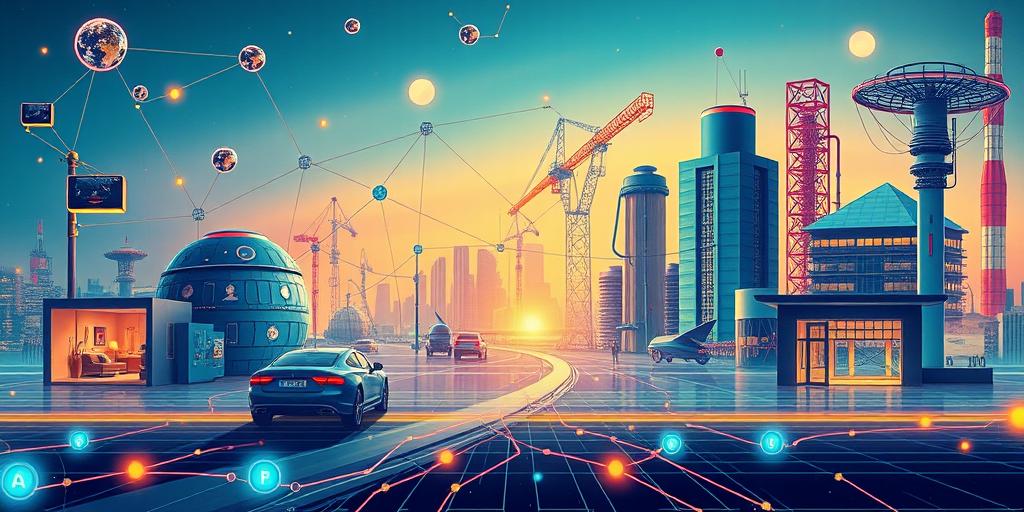The Internet of Things (IoT) has exploded onto the scene, transforming how we live, work, and interact with the world around us. But it wasn’t always this way. From humble beginnings as simple connected devices, IoT has evolved into complex, interwoven smart ecosystems. Get ready to explore this fascinating technological journey as we uncover the history, present state, and future possibilities of this ever-growing network!
From Simple Connections to Smart Networks: The Early Days of IoT
The seeds of the IoT were sown decades ago, long before the term itself was even coined. Early examples of connected devices include automated industrial machinery using remote control and basic telemetry systems monitoring infrastructure like pipelines and power grids. These early systems, while limited in functionality and connectivity, laid the groundwork for the sophisticated IoT solutions we see today. Think about the early days of remote monitoring of industrial equipment – these were rudimentary forms of data collection, but crucial steps in enabling more sophisticated connected systems. These early implementations highlighted the potential of remote monitoring and control, paving the way for more complex IoT applications. The limitations of those early systems, such as restricted bandwidth and limited processing power, forced early innovators to develop creative solutions. The ingenuity used to overcome these challenges laid the foundation for many of the advancements we enjoy today in IoT technology. The challenges of these early systems taught us valuable lessons about efficient data transmission, and the importance of reliable communication protocols.
The Rise of the Microchip
The development of the microchip was a key turning point. Suddenly, it became feasible to embed powerful computing capabilities into smaller, more energy-efficient devices, enabling the creation of smart sensors, actuators, and other components that could easily be connected to a network. The development of standardized communication protocols, such as TCP/IP and later MQTT, also dramatically increased the feasibility and affordability of creating IoT solutions. As communication networks expanded, data transmission costs decreased significantly and the potential for IoT application expanded dramatically. The emergence of the wireless revolution, particularly Wi-Fi and later, cellular technologies like 3G and 4G, made it increasingly easy and cost-effective to connect devices to the internet without the need for physical cabling. The combination of low-cost computing, widespread network connectivity and open communication protocols finally enabled the IoT explosion.
The IoT Today: A World of Connected Devices
Today’s IoT landscape is vastly different. Billions of devices are connected, forming massive networks that generate and process enormous amounts of data. From smart homes with voice-activated assistants to self-driving cars navigating complex city streets, and industrial facilities optimizing energy consumption, the range of IoT applications is breathtaking. We see IoT in use in almost every industry, from agriculture to healthcare, transportation to manufacturing. Consider the impact on precision farming, where IoT-enabled sensors monitor soil conditions, helping farmers optimize water and fertilizer use. Or think about predictive maintenance in industrial settings, where IoT sensors detect anomalies in machinery, preventing costly equipment failures before they occur. The capabilities and applications of IoT are continuously expanding as technology advances and cost decreases.
Smart Homes, Smart Cities, Smart Everything
The term “smart” is often used in conjunction with IoT. Smart homes, smart cities, smart grids – these are all examples of how IoT is transforming our world into a more interconnected, data-driven, and efficient place. We witness this in the burgeoning smart city initiatives across the globe, which aim to optimize urban services such as transportation, waste management, and energy consumption. This involves sophisticated sensors embedded into infrastructure, which collect vast amounts of data, enabling more efficient resource allocation and improved quality of life for residents. This illustrates how the convergence of different technologies like AI, Big Data, Cloud Computing, and IoT is leading to the creation of hyper-efficient and responsive ecosystems.
The Future of IoT: A Glimpse into Tomorrow
The future of IoT is as exciting as its past has been transformative. We can expect to see even greater levels of connectivity, with the rise of 5G and beyond delivering faster speeds and lower latency. Artificial intelligence (AI) and machine learning (ML) will play an increasingly critical role, enabling devices to learn and adapt to changing conditions, improving efficiency, and creating more autonomous systems. Expect even more sophisticated applications, like the widespread deployment of autonomous vehicles, the continued expansion of smart cities, and increasingly personalized experiences enabled by advanced analytics and data insights. The integration of IoT data with other data sources, like weather data or traffic patterns, will lead to a more holistic and accurate understanding of complex systems, allowing for more effective decision-making. The combination of IoT data with other data streams allows for a more holistic and accurate understanding of complex systems.
Security and Privacy Concerns
As the IoT expands, so too do security and privacy concerns. The interconnected nature of IoT devices means a potential vulnerability in one device could compromise the entire network. Ensuring the security and privacy of IoT systems is paramount. The development of robust cybersecurity measures is critical to mitigating the risks associated with the increasing number of interconnected devices. Secure communication protocols, strong authentication mechanisms, and data encryption are essential aspects of a secure IoT infrastructure. Furthermore, stringent data privacy regulations and ethical guidelines are critical to ensuring the responsible use of the massive data collected by IoT systems.
The future of the IoT is bright, but only if we address security and privacy concerns proactively. By prioritizing these issues, we can unlock the full potential of this transformational technology while protecting users and their data. The interconnectedness of devices within IoT ecosystems also poses considerable challenges in terms of data management and security. This requires significant investment in security infrastructure and processes to protect sensitive data.
Embrace the interconnected world! Dive into the incredible possibilities of the IoT today. Start exploring the possibilities of smart technology and see how it can revolutionize your life. Learn more and join the IoT revolution!




